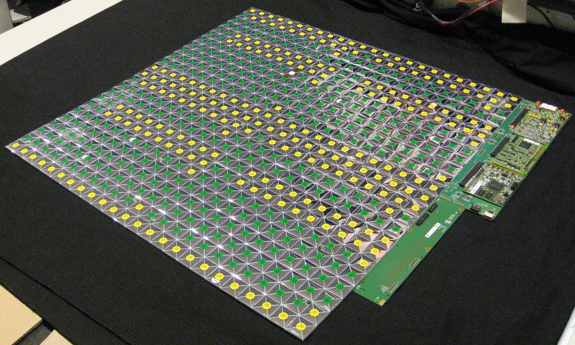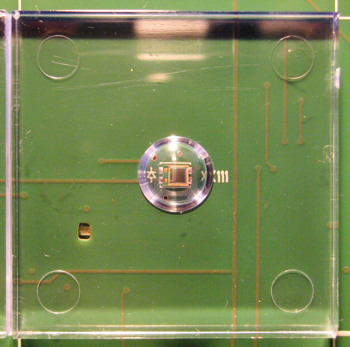HCAL
SiPM-on-tile HCAL R&D
The HCAL group at DESY leads the effort in the CALICE collaboration to develop highly granular hadron calorimeters based on scintillators read by silicon photo-multipliers (SiPMs) for a future linear collider detector. The group also participates in the R&D for the upgrade of the CMS experiment at the LHC and develops the active elements of the scintillator section of the high-granularity end-cap calorimeter. The developments are supported by the European initiative AIDA-2020.
Introduction
In collider experiments at the TeV scale heavy objects like Z, W and Higgs bosons or top quarks are copiously produced. They predominantly decay into final states with jets and need to be identified on the basis of their invariant mass in order to study the underlying physics. Optimal energy and mass resolution of all components of the final state will be achieved when the final state particle flow is reconstructed with highest possible detector granularity. Whereas all charged particles can be measured with sufficient precision in a large volume tracking system, the neutral particles have to be reconstructed and identified in a calorimeter system: an electromagnetic calorimeter (ECAL) followed by a hadronic calorimeter (HCAL) with highest possible granularity.
The CALICE collaboration studies the performance of such calorimeters within a broad R&D program for high granular ECAL and HCAL solutions following several technological options.

Active layer of the new HCAL prototype with scintillator tiles, wrapped in reflector foil, and integrated read-out electronics.

One scintillator tile with SiPM on the read-out electronics board.
CALICE Scintillator HCAL
The CALICE scintillator HCAL subgroup has built a small prototype called MiniCal as well as a 1 m3 steel/scintillator sandwich sampling calorimeter called physics prototype. It was studied in a series of test beams 2006-2011, from which 11 journal publications resulted.
In 2017-18 a realistic prototype with fully integrated read-out electronics, incorporating 23'000 latest-generation SiPMs, is constructed for beam tests staring in 2018 at CERN. The prototype has 40 layers, each equipped with 576 scintillator tiles of 3x3 cm2 size.
Further reading:
- ILC detector TDR
- CLIC CDR: "Physics and Detectors at CLIC"
- Mark Thomson: "Particle Flow Calorimetry and the PandoraPFA Algorithm"
- Review: "Experimental Tests of Particle Flow Calorimetry"
CALICE Institutes working on the Tile HCAL
| Country | Institute | Contact person |
|---|---|---|
| Czech Rep. | IPASCR Prague | J. Cvach |
| France | LAL Orsay | R. Poeschl |
| France | OMEGA | C. De La Taille |
| Germany | DESY | F. Sefkow |
| Germany | Hamburg University | E. Garutti |
| Germany | Heidelberg University | H.-C. Schultz-Coulon |
| Germany | MPI Munich | F. Simon |
| Germany | Wuppertal University | C. Zeitnitz |
| Germany | Mainz University | V. Büscher |
| Japan | Tokyo University | W. Ootani |
| Japan | Shinshu University | T. Takeshita |
| Norway | Bergen University | G. Eigen |
| Russia | JINR Dubna | I. Tiapkin |
| Russia | ITEP Moscow | A. Drutskoy |
| Russia | LPI Moscow | M. Danilov |
| Russia | MEPhI Moscow | S. Somov |
| UK | Imperial College London | P. Dauncey |
| UK | University College London | M. Wing |
| USA | University of Texas Arlington | A. White |
| USA | Northern Illinois University | V. Zutshi |
| Europe | CERN | L. Linssen |
Scintillator part of CMS HGCAL
For the high luminosity upgrade of the LHC in the mid 2020s, CMS will replace their endcap calorimeter by a high granularity calorimeter HGCAL, designed to withstand the increased radiation levels. The fine segmentation enhances the capabilities for the reconstruction of collimated boosted heavy objects, and, together with excellent timing resolution, meets the higher demands of pile-up rejection. The design, with a front section using silicon as active medium, and a rear section based on the SiPM-on-tile technology, heavily builds on the CALICE developments.
For the rear section, with 400'000 SiPM-on-tile channels, the DESY HCAL group develops the design of active elements, so-called tile boards, consisting of read-out electronics boards with SiPMs and scintillator tiles or mega-tiles, including procedures for mass production and quality assurance.
Further reading: CMS HGCAL TDR (to come, not public yet)
Further information
In case you got curious and want to learn more, also have a look at:
- calorimetry - a brief desciption of the working principle
- particle flow - the basic ideas and problems of this Ansatz
- MiniCal - a small prototype to chose the read out technology
- physics prototype - a proof of principle prototype as described above
- engineering prototype - a prototype scalable to the full collider detector
For people working on this project
There are some additional information about:
- testbeam - data taking at CERN and FNAL
- elog - even more detailed run by run information
- flc wiki - some hints for software users as well as developers
- SiPM database - specifications for each SiPM
- papers - written in our collaboration
- meetings - talks on weekly, HCAL main, CALICE meetings and conferences
- further links - on ILC related R&D, DESY, CALICE, ...

